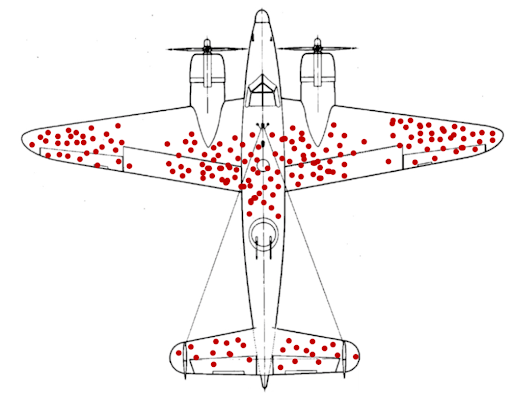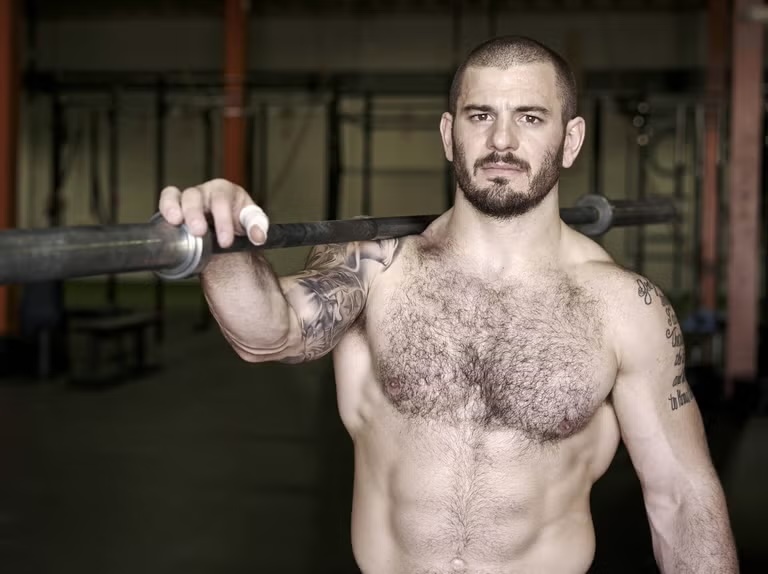Where do we reinforce the plane?
Early analysts assumed: “These are the weak spots. Let’s reinforce them.”
But statistician Abraham Wald pointed out a different truth: these were the planes that made it back.
The real weak spots? The areas with no bullet holes because the planes hit there didn’t return at all. They were destroyed. Never studied. Never counted.
This is survivorship bias in action. What is Survivorship Bias?
Survivorship bias is a mental trap.
It happens when we only pay attention to success stories the people or things that "made it" and ignore everything that failed and disappeared.
The result? We draw distorted conclusions about what works, and why.
Startup Myths: The Illusion of the "Garage Billionaire"
What we don’t see?
The thousands who dropped out, launched something in their garage, worked 16-hour days… and then quietly folded, broke, and went back to regular jobs.
Survivorship bias filters out the failures, so it seems like this path is a proven formula.
It’s not.
Hustle Culture and “Self-Made” Millionaires
On social media: “I just believed in myself, worked hard, and now I make £100k a month coaching other people on how to make £100k a month!”
What you don’t see are the countless others who believed just as hard, worked just as much, and lost everything.
The difference? Only the survivors write the posts.
Instagram Fitness and Transformation Programs
The shredded guy holding the supplement tub. The girl showing her abs under a ring light.
But you don’t see the thousands who tried the exact same plan and gave up.
Or got injured. Or saw zero results.
Because the algorithm doesn’t reward the ones who quit. Only the success stories go viral.
Celebrity Wellness Routine
Zak Efron, Hugh Jackman, Idriss, Chris Hemsorth, J-Lo, Rock
A-list stars credit their success to Athletic Greens, Journaling, Meditation, or 4am wake-ups.
But they’re already rich. Genetically gifted. Surrounded by trainers, chefs, and nannies.
Millions copy their routines… and wonder why they don’t get the same results.
Survivorship bias masks the hidden advantages.
Steve’s Travel Vlog…
You hear the story: “I left my job, booked a one-way ticket, and now I make money blogging on a beach!” Or my personal favourite the Nomad Motorcyclists who travel the world funding their adventures with a wildly successful YouTube Vlog.
But for every travel influencer with a brand deal, there are dozens who ended up broke, stressed, or quietly back home, deleting their Instagram account… and writing articles on substack pretending it wasn’t them on the motorcycle
When I first got into fitness, I believed all the hype.
I saw routines from Arnold Schwarzenegger: 600+ working sets per week. Insane volume. Superhuman output.
Arnold’s Crazy Training Volume Documented Here
The message: “Just do this and you’ll look like him.”
But what got left out?
Arnold’s genetics: Elite even among elites.
Arnold's Stats
7 time Mr. Olympia - 1970-75, 1980
Height - 6'2"
Weight - 235 lbs
Arms - 22 inches (Many sources claim this number to be inflated) No pun intended
Chest - 57 inches
Waist - 34 inches
Deadlift - 710 pounds
Bench Press - 440 pounds
Squat - 470 pounds
•His full-time lifestyle: Eating, lifting, and recovering all day.
•PEDs: Performance-enhancing drugs were a massive factor — never mentioned on the glossy routine handouts.
Most people who tried his plan burned out, got injured, or gave up.
You only heard from those who survived it.
The Bulgarian Weightlifting System
Another perfect case study. (Please don’t try this at home folks!) Sorry but I’ve been dying to sneek that into a post somewhere.
Under coach Ivan Abadjiev, Bulgaria dominated Olympic lifting in the ‘70s and ‘80s. His athletes trained to max effort, multiple times a day, with almost no variation. Competition lifts and squatting on repeat, not just daily but multiple times per day! Not much in the way of deloads or easy workouts.
Much of the recovery that made this system even remotely possible came not just from sleep and food but from state-sponsored doping programs. Athletes were often supported with anabolic steroids and other performance-enhancing drugs, making it a system designed for and survivable only by genetically elite, pharmaceutically enhanced lifters.
People tried to copy it all over the world.
But no one asked the key question: “What happened to everyone who didn’t survive that system?”
Turns out most broke! Only the freaks of nature survived (Botev above survived) Only they made it to the podium. Only they were visible.
The Problem with Training Like Mat Fraser
Another modern example of survivorship bias comes from the world of CrossFit, where 5-time Games champion Mat Fraser built a reputation for relentless, high-volume training sometimes up to 6–8 hours a day.
With an Olympic lifting background, elite genetics, and full-time support (he didn’t cook, clean, or handle much outside training), Fraser was a machine built for the sport. But when he turned to coaching others through his HWPO brand, cracks began to show. Athletes who tried to follow his volume-heavy methods often struggled to keep up some burned out, others quietly moved on.
Even elite prospects like Mal O’Brien, once under his guidance, eventually stepped away. The lesson? Fraser’s success wasn’t just about hard work or a magical program. It was the result of a perfect storm of talent, resources, recovery, and lifestyle. Mimicking his training without those factors is like reinforcing bullet holes in the wrong parts of the plane you're learning from the survivor, not the system that created the casualties.
Why This Matters (And What To Do About It)
Survivorship bias warps your expectations. It:
Makes success look common and replicable when often - it’s not.
Causes you to misjudge risk.
Leads you to waste time on strategies that work for the few, not the many.
- Zoom out: Ask yourself, “Who didn’t make it?” Why?
- Question the narrative: Is this success story showing the full picture?
- Choose sustainable strategies: Especially in fitness, business, and life.
- Embrace the amateur mindset: Most people make more progress training like an amateur not a genetic freak on PEDs.
Even the pros started there.
Full Circle: Back to the Bullet Holes
The most important data is often what you don’t see.
The failures.
The unspoken.
The parts of the plane that never made it home.
If you only study the survivors — you’re reinforcing the wrong parts of the system.
Your Turn
Where have you been following survivors and ignoring the missing data?
Have you ever burned out chasing someone else's routine or business model?
Let me know in the comments and if this helped you see things differently, please share it.










